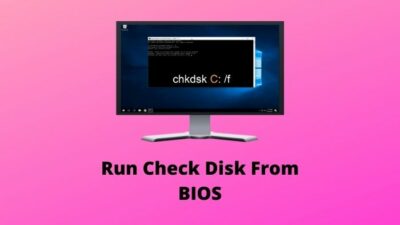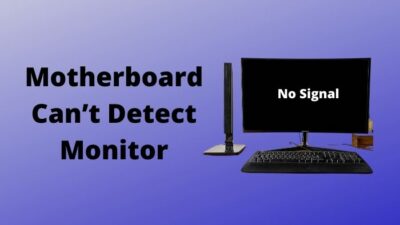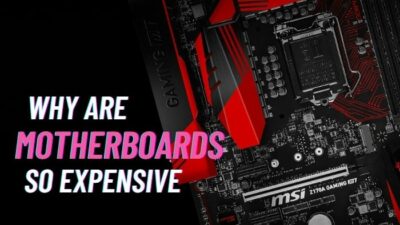Are you concerned about your computer’s motherboard heating gradually? And you have noticed some performance issues, but not sure why that is happening? Don’t worry. You are in the right tech solution web.
Being a hardware geek, I know the worst possible issues you might face on your computer and effortless workarounds to get you out of those problems.
As you know, the motherboard is the most important component of your system cause it helps other parts of your system connect with each other and share data, as well as power, and so on. For that functionality, it is okay to raise the temperature a bit. But to what extent? And what should I do if the motherboard overheats?
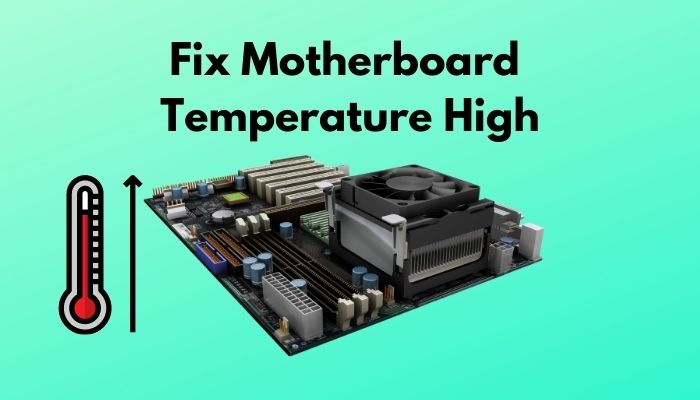
I will demystify all of those queries after answering the most important question,
Why does a motherboard temperature get high?
The list is lengthy, don’t you think? But the good thing is, I’ve got you covered. Read the following passages to get rid of the problem in an elegant manner.
How to Check the Temperature of my Motherboard?
There are several ways to find out whether your motherboard is high in temperature or not. In my opinion, checking the warmth of the mainboard is necessary.
When you check the temperature, that means you are concerned with the health of your PC components. And if you are only a little bit worried, the lifespan of your PC components is likely to be increased.
For your sake, I have shortlisted the most efficient methods to test your motherboard’s temperature.
Here are the methods to check motherboard temperature:
1. Open Hardware Monitor
If it is not the best tool to find your mainboard’s temperature, it is one of the best free tools. You can utilize this hardware monitor with both Windows and Linux operating systems.
Download by searching online and install it on your system. You shall find the user interface after launching it from your system. The best feature about this tool is you can monitor all of the components available on your system.
Expand the motherboard option ( it will be named after the exact model you currently have) and find the present temperature with minimum and maximum value of recent uses.
Go through our epic guide on Is SSD Compatible with All Motherboards.
2. Core Temp
Try the latest version of this utility if you want to get the exact information of your CPU’s temperature. This compact program shows the temperature of every individual core of the processor.
From that, you can get an idea of this utilities’ accuracy. Download the utility from the official website and launch it on your system. You can monitor the data with a graph view so that you can visualize it.
3. Speecy
Speecy is the most advanced tool of all that I have mentioned. Whenever you are not sure of the reason behind the overheating, this tool indicates the most possible reason behind it.
So, you get the proper info, including the process of eradicating the issue. Not only that, this tool has a unique feature by using what you can save the result of previous hardware trouble and share the data with anyone.
Also, check out our separate post on Motherboard Boot Without CMOS Battery.
What Happens if Motherboard Gets too Hot?
Before asking that question, you need to understand why the motherboard heats up? Though I have cleared out the topic on the first passage, you need some additional information on that. As all of the data that keeps your computer up and running communicates through your computer’s motherboard.
How? The data transfers in a series of commands. The more data travels through, the more commands are processed by your computer, and simultaneously more heat is generated.
So, when do you determine your mainboard’s temperature is over the limit?
The maximum temperature for any of the computer parts is not more than 80 Degree Celcius. If you live in the coldest regions of the world, the temperature should not be more than 60 degrees. But, in general, 80 degrees can be selected as the highest mark.
Well, now you know when you should determine that your motherboard is excessively heated up. What happens when it does that?
Go through our epic guide on Will Motherboard Turn On Without CPU.
Here is what happens when your motherboard overheats:
- If the motherboard is heated up more than usual, you should notice freezing and glitches on your system. Even if you have a high-performance computer.
- The most terrifying scenario is BSOD (blue screen of death). A random BSOD error appears on the screen if the mobo is too fervent.
- Your motherboard might not recognize the other compatible components if the temperature is too high.
- When a motherboard’s temperature is excessive than usual, the capacitors of the hardware might wear out and fracture on the surface could show up.
Yes! Things can get out of hand if the temperature is too high. To avoid this situation, reducing the temperature will be the best idea. Read the following part if you don’t want to face the consequences of overheating.
How to Lower the Temperature of my Motherboard?
Now that you know the actual reasons for a motherboard overheating and the consequences of that situation, it is time to lower the temperature of your motherboard.
I have enlisted the best methods you can implement in this part. But, before you jump to the section, I suggest you turn off your computer. Open the casing if you are using a desktop and clean out the dust from the inside.
Another variable you can make sure of is the room temperature. That is so much important if you live in the warmer region of the globe. If the average warmth of your room/office remains more than 20 degrees celsius, you should place the computer in a less warm space.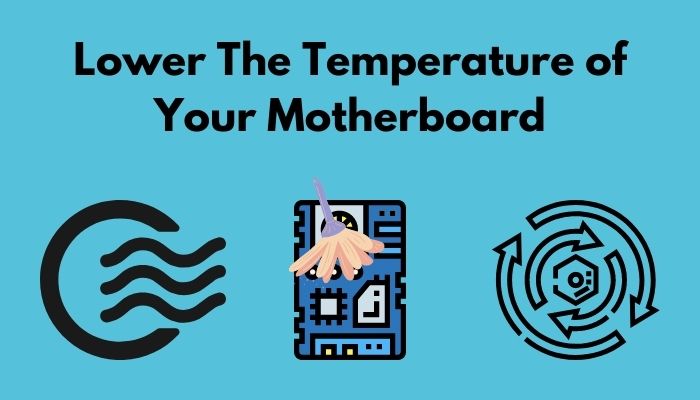
Here are the methods to lessen the temperature of your motherboard:
Ensure Proper Airflow
One of the most possible reasons behind your motherboards overheating is the lack of sufficient airflow. That happens when the PC components are clustered together, and there is no way to withdraw the regular heat.
Another scenario is when any of the cooling fans are not working or spinning slower than regular. Open the casing and check if the cooling fan or the PSU fan is fully functional. Change them if needed.
Don’t keep the computer in a tight area such as your desk cabinet. Ascertaining adequate airflow will help your motherboard to cool down.
Follow our guide to fixing Will Motherboard Boot Without CMOS Battery
Clean up the Components
Dust and debris intensify inside the PC cabinet from time to time. There’s no way you can stop it. What problem they create is, excessive dust increases friction, and not cleaning the cabinet for a certain time leads to raising up the heat.
To avoid that, plug out all of the cables, unscrew the case, and clean out the dust. You need to provide proper attention to cleaning the CPU fan. That is one tricky area to clean up. I prefer using an air blower. You can buy cheap blowers in every superstore.
Use a soft brush instead, if you don’t have a blower. Motherboard cleaner liquid is also preferable, if possible.
Update BIOS
If the motherboard’s BIOS is outdated it doesn’t perform to its potential. The temperature controllers can’t function properly, hence the overheating. Updating the BIOS version can help you with this situation.
Download the updated BIOS file from the manufacturer’s website, move the files into a USB drive, and manually update from the boot menu.
Updating the BIOS to the latest will resolve the explained issue. And motherboard overheating will no longer be a problem.
Disable Overclocking
When it comes to overclocking, high temperature is a common factor. When you overclock a component, you unlock the limit of that particular hardware.
In most cases, people know to what extent their mobo can perform and if that’s doable without frying up other components of the PC. But, if you don’t know the heating factor of overclocking and already have overclocked your motherboard, you can disable it.
Configure the motherboard to factory reset settings. The heating issue will be resolved itself.
Here’s a complete guide on can Motherboard Bottleneck GPU.
Fix the Faulty Cooling System
If your PC cooling system is insolvent, try adopting a different one. Change the additional cooling fan. You can utilize a cooling pad if you are a laptop user.
You can also check the thermal paste by removing the CPU fan. If that part is dried out, try reapplying the paste. Don’t use your hand, though. Apply the paste on the processor, and arrange the fan like it used to be.
The reason I am emphasizing the cooling system is in most cases, overheating occurs because of a broken cooling system. Try fixing it.
Replace the Damaged Component
If the components of your PC cabinet are old, try checking each of the components on another computer.
If any other component is overheating it could trigger your motherboard also to heat up. Check the HDD twice as it has a reputation for overheating. Older versions of graphics cards have the record of generating heat
When any part is found as the culprit, try replacing it with a new one. Repairing any part will delay the falling but, that will descend, eventually.
These are the most workable methods to reduce the heat of your motherboard. Following them would bring an excellent result as I have experienced.
Wrapping Up
Throughout this entire article, I have tried to acknowledge the heating issue of a motherboard. Why it happens, how to oppose the situation, and so on.
If you have read every word I put there, I believe your motherboard’s overheating issue will be solved immediately.
Then again, if you feel uncomfortable applying those methods, or have any queries about any of the discussed matters, feel free to write a comment below. I will answer as the earliest.

